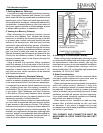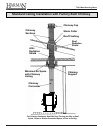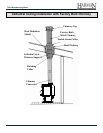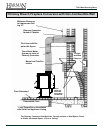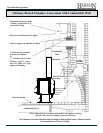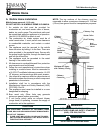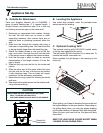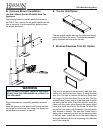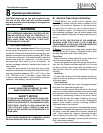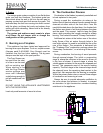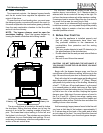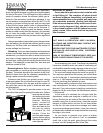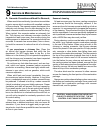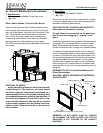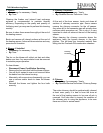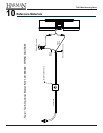
23
Save These Instructions 3-90-08560 Dry Seasoned Wood Only!
Select only . Wood for burning
should never be exposed to rain or extremely damp
conditions. Hardwoods are favored because they are
heavier and contain more heating capacity (BTU’s) per
load than do softwoods. Fuel wood should be split and
stored under cover for “seasoning” - at least a year is
recommended. Your stove is not an incinerator - do
not burn garbage, painted or treated wood, plastic, or
other debris.
Keep the area around the stove free from clutter.
Keep all combustibles, including fuel, beyond the code-
required clearance distance (48" or 1215 mm in the
U.S., 1525 mm or 60" in Canada). Never store fuel
in front of the stove where it could interfere with door
operation, safe loading, and ash removal.
Before you install and/or operate your
wood stove, please read the entire contents of this
manual. Pay particular attention to the explanation
of draft and its effect on stove performance in
the Installation section. By following the installation
and operating guidelines, you will ensure proper draft
and gain maximum efciency and enjoyment from your
stove.
Your stove has a large glass-paneled door
for loading and re viewing, a separate smaller door
for removing ashes and a top loading door.
Before opening, always check for wood, embers, or
ash that may be ready to fall out of the door.
To open the glass door, open the bypass damper rst,
then turn the handle clockwise and pull out; to close
the door, push the door closed with the handle in the
open position, then turn, counter-clockwise, to engage
the latch.
To open the ash door, lift up the handle and pull out.
Close the door by pushing in and pushing the handle
all the way down.
To open the top load door, open the bypass damper
and then lift to open the top load door.
All doors must be closed while the stove is in normal
operation, and the gaskets routinely examined for wear
and replaced when necessary. Good door seals are
important for maintaining control of the stove. Never
operate with the ash door open. Operating the stove
with the ash door open, or with a door inadequately
sealed, could create a serious overring condition
(discussed later in this section).
The glass used in your stove is manufactured to exact
standards to withstand the high heat of the re, but like
all glass, it must be treated with common sense and
care. Never abuse the glass by slamming the door
shut or striking the glass with a heavy object. If the
glass is broken or damaged, do not operate the stove
until it has been replaced
(See instructions in the Maintenance section.)



